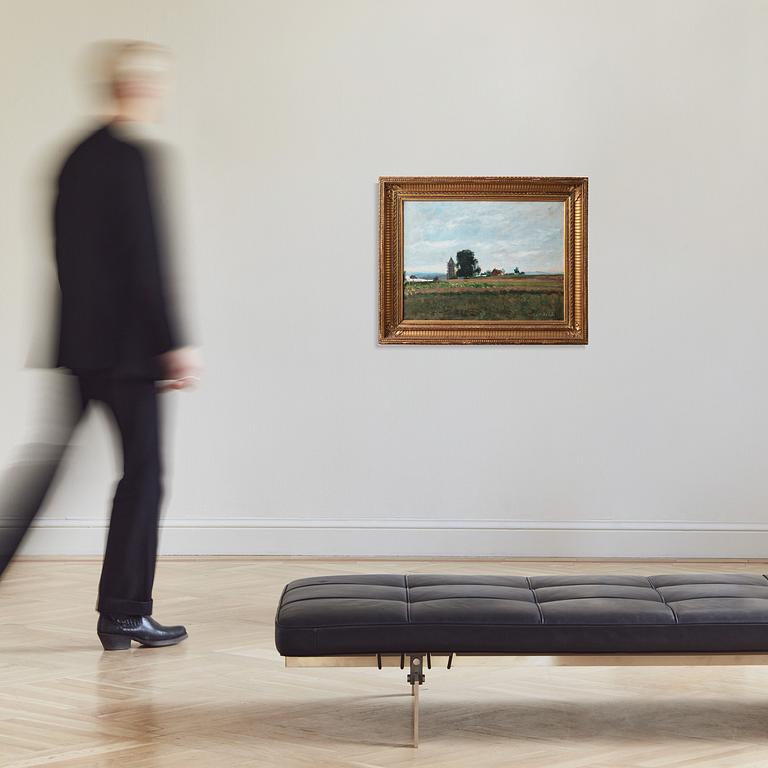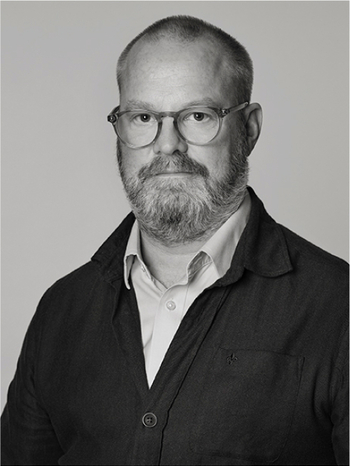Carl Fredrik Hill
'View over Champagne' (Utsikt mot Champagne)
Signed CF Hill. Canvas 54.5 x 73 cm.
Provenance
The collection of the manufacturing director K.D. Santesson, Malmö, Sweden.
Private Collection, Stockholm, Sweden.
Exhibitions
Malmö Museum, 'Carl Fredrik Hill - retrospektiv utställning', 1933, cat. no 95 (Mr K.D. Santesson, Eslöv); Malmö Rådhus, exhibition arranged by Föreningen Malmö Konsthall, 'Carl Fredrik Hill (1849-1911)', March1943, cat. no 46 (Mr K.D. Santesson); Nationalmuseum, Stockholm, 'Carl Fredrik Hill - Minnesutställning', September - October 1949, cat. no 113 (38) (Mr K.D. Santesson); Universitetet - Skånska Konstmuseer, 'För att känna Hill', April 19 - May 3, 1953, cat. no 6 (Mr K.D. Santesson); Nationalmuseum, Stockholm, 'Carl Fredrik Hill', October 1, 1999 - January 16, 2000, cat. no 54; Åmells Fine Art Gallery, London, November 2000, cat. no 176A.
Literature
Viggo Loos, 'Friluftsmåleriets genombrott i svensk konst 1860-1885', 1945, illustrated p. 215, mentioned p. 219 and also mentioned on page 340; Adolf Anderberg 'C.F. Hill', 1951, illustrated pl. 47, listed in the catalog under the section 'I Champagne' p. 306; Konst i svenska hem, vol 9, 835, "Fabrikör Kristian David Santesson, Malmö", p. 498, ill.
More information
In 1873 Carl Fredrik Hill finally arrived in Paris to try his luck as an artist. He was twenty-four years old. The time in Paris was a happy one for Hill. At last, he felt liberated from the academy and could paint in a new environment. He was strongly inspired by Camille Corot, the famous French landscape painter. If you study the paintings Hill executed around 1873, and in the years that followed, the similarities to Corot, in both imagery and choice of colour, are clearly visible. A recurring subject at this time was a landscape with treetops set against the sky, rocky sections, gravel roads and sweeping fields. Sometimes with a single human figure or small group, that seems almost to shrink in comparison with the grandiose nature surrounding them.
In his first year in Paris he managed to get a painting accepted and exhibited at the Salon. He also received good reviews in the Swedish papers and, when he visited his family in Lund during the summer, was celebrated for his success. Hill returned to Paris and during the following years he searched for new subjects in the areas just outside of the city. Around Europe rail travel had just begun picking up in earnest and new stations were opened on the lines operating out of Paris. In 1875 a new station in Luc-sur-Mer, on the Atlantic coast, was opened. Between 1873 and 1876 the development of the railway made an intensive period of travelling possible for Hill. His travels stretched from the Atlantic coast and the fishing village of Luc-sur-Mer in the northwest all the way to Boi-le-Rois, Fontainbleau, and Montigny by the river Loing, southwest of Paris. In 1876 he followed the Oise river northwest and discovered Isle-Adam and Champagne, home of the French artist Jules Dupré and several of the impressionists.
Bo Wingren describes this time as follows: “At the start of summer in 1876 Hill found himself in Montigny, a small town by the Loing, close to Grez, and much visited by both French and foreign artists. This year was perhaps Hill’s most transformative and creative period in France. The asphalt colour disappears from his palette, the painting is flourishing, his production is impressive. A part of this development must be attributed to Hill’s experience of the second impressionist exhibition that year”. (Tillbaka till Normandie. Nordiska Konstnärer i Normandie 1850-1900, 1992)
Hill was rejected by the Salon in both 1876 and 1877, but was determined to keep trying. He had grand plans for himself as well as for his artistic practice, and he travelled and worked diligently on new paintings. In the spring he was in Champagne, where he depicted the village and the nearby river in several works. In the summer he was in Montigny and in the late summer in Luc-sur-Mer, where he painted vistas of steep coastal rock faces and tidal beaches. 1876 was a productive year for Hill and he executed a large number of expressive and diverse landscape paintings, marked both by nature and his state of mind. The following year, heartbroken by the second rejection by the Salon, he found solace in the landscape by Bois-le-Roi, which became the main centre for his painting. He would come to paint several works depicting flowering fruit trees, the series Trädet och flodkröken, as well as the painting Villa vid Seine. He returned to Champagne in September 1877. According to Viggo Loos, “It is no middle ground that he seeks. Wild torment and deep harmony are both present during these years of creativity. What he seeks is the true expression of what lies at the heart of his personality and the tension of its emotional states”.
The present painting, ’Utsikt mot Champagne’, was made during one of his stays in the area in 1876 or 1877. It is a classic depiction of fields, and diametrically different from the bold imagery of the Montigny stone quarries and the cliffs of Luc-sur-Mer, painted during the same period. In Utsikt mot Champagne the colour palette is muted and the light is reminiscent of the approaching autumn. In the foreground, the fields are defined by their division into earthy colours and sections of green, and we almost get the feeling that the artist has placed his easel in a ditch. The straight line of the horizon is interrupted by a tower, partly obstructed by a leafy tree. The image emanates a sense of calmness and harmony, a temporary return to Corot’s landscapes where the French field rests unwavering beneath a greyish blue sky.
Despite working intensely the great successes that Hill hoped for failed to materialise. In a final effort, around Christmas time in 1877, he attempted to get eighteen large paintings done for the world exhibition in Paris the following year. Only one painting would end up being accepted. During this period Hill suffered a severe psychotic attack and was taken into the care of Doctor Blanche’s clinic in Passy outside of Paris, where he was sectioned against his will. A year or so later Hill was moved to Roskilde in Denmark, and from there to Sankt Lars’s hospital in Lund. In March 1883 he was returned to his family’s house in Lund and from then on he was cared for at home by his mother and his sister Hedda. Carl Fredrik Hill’s second creative period now commenced, which resulted in thousands of drawings using pastels, executed during the twenty-eight years that the artist spent in his childhood home up until his death in 1911.
Artist
Carl Fredrik Hill was a Swedish artist born in Lund. Hill is considered one of Sweden's formost landscape painters. His fate and artistry are perhaps the strangest but most interesting in Swedish art history. Born in an academic home in Lund, despite his father's protests, he managed to begin studies at the Art Academy in Stockholm and then traveled to France, where he came in contact with Corot's landscape painting. He found his inspiration in Barbizon and later on the River Oise, in Luc-sur-Mer and Bois-le-Roi. He painted frantically with the hope of being accepted into the Salon de Paris. Already during his student years, he struggled with an incipient mental illness and at the age of 28 he was taken to the mental hospital in Passy. During the hospital stay he began his rich production of drawings and then continued with the production after his return to Lund, where he was cared for by his family for the rest of his life. In thousands drawings, a fantasy world of figures scenes appears. Today, Hill's river landscape and flowering fruit trees from the years in France, together with the visionary drawings from the period of illness in Lund, have received great recognition. His art depicts a loneliness and longing that is easy to get caught up in. He is mainly represented at the Malmö Museum and at the National Museum in Stockholm.
Read more



































































